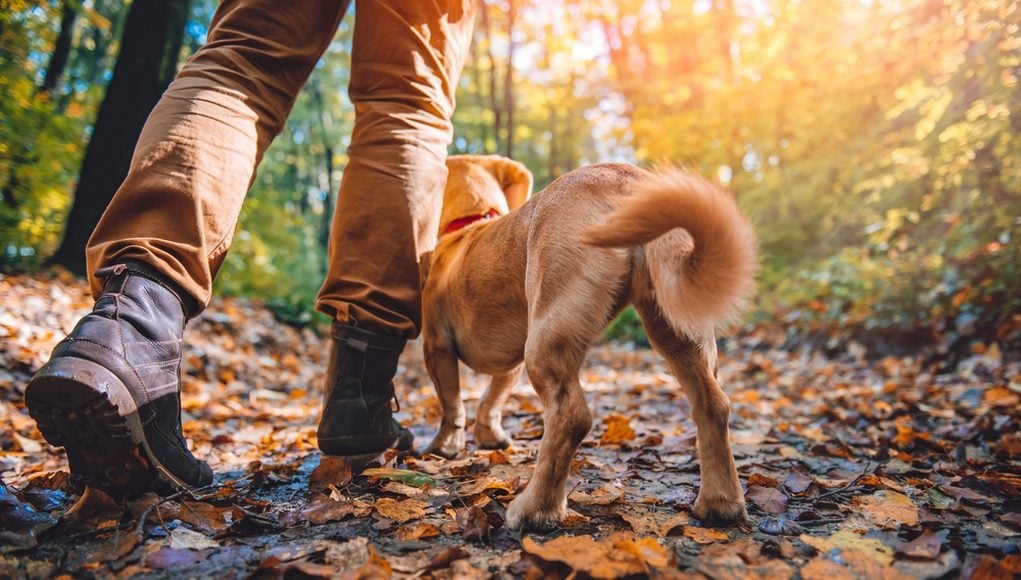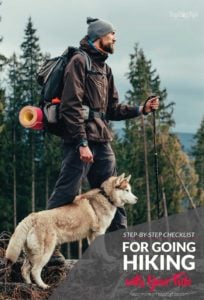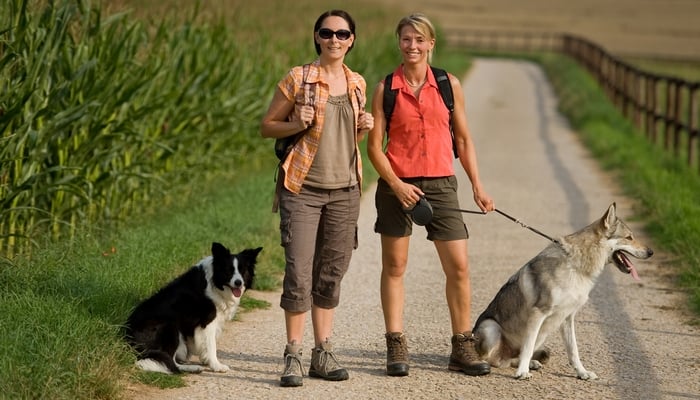Taking a hike with your dog might not seem like it requires any preparation, but the proper precautions will ensure both your and your dog’s safety and comfort. Many owners believe that hiking with dogs is nothing more than a walk through the wilderness with your pet, but it's much more strenuous than that. There's a lot to do before, during and after the hike!
Getting ready for a hike with your dog actually begins days before you step foot in the woods. There is lots to pack, and you may need to take a quick trip to the vet as well. After all, hiking isn't for every dog, and you have to be sure that your Fido is up to the physical demands of the trail.
There is so much to plan for, and no one would blame you if you missed a few details. That's why it's so important to have a checklist, like this one, to follow. If you have a set list, you're sure to get everything done in time for the hike, and you won't forget to pack any essential items.
There are a lot of great resources here on Top Dog Tips for owners that want to take their pet hiking. Whether it's your first trip out with your pooch or you are an experienced hiker, you may want to check out these:
- 14 Safety Tips and Tricks for Hiking with Dogs
- Dog Hiking Gear Guide – 13 Items You Need When Hiking with Dogs
Now, here's a checklist that you can follow to make sure your hike is safe and fun.
37-Step Checklist for Hiking with Your Dog
When Prepping for the Trip…
1. Check that your dog is up to date on vaccinations for your location by calling your vet.
2. Make sure that your dog is up to date on preventative medications such as heartworm prevention and flea and tick preventatives.
3. Verify that your dog’s ID tags and microchip information reflect your current contact information.
4. Watch your dog for any signs that he may not be up to a hike – diarrhea, lethargy, general signs of illness, etc.
5. Check your dog over fully to be aware of any cuts or scrapes that may interfere with his ability to hike with you.
6. Look through your first aid kit to check that it is both stocked up and contains products that are not expired.
7. Research the area where you will be hiking to ensure that it is safe terrain.
8. Take note of the weather forecast for the day of your hike to make sure that it will be safe for you and your dog.
9. Pick a hiking location, and plan your hike with your dog’s physical capabilities in mind.
10. Check your dog’s collar, leash, and harness to make sure that they are intact and show no signs of wearing thin.
11. Recruit someone to hike with you if you intend to walk with more than one dog. You should always keep the human to dog ratio of 1:1 to maintain better control over any situation that might occur.
RELATED: Dog Hiking Gear Must-Haves
Leaving for the Trip…
12. Cover the backseat of your car with a car seat cover to protect against any wetness, dirt, or debris.
13. Make sure to tell someone where you are going and when you expect to be home in case you run into trouble on your hike.
14. Check that your cell phone is fully charged.
15. Ensure that both you and your dog have eaten approximately an hour or two before leaving so that you don’t get hungry on your hike. DO NOT hike immediately after giving your dog a meal, it can contribute to bloating or a general ill feeling.
16. Make sure both you and your dog are properly hydrated before you head out.
17. Check that you have your first aid kit, water, waste bags, and phone with you when you begin hiking.
18. Put your dog’s hiking boots on them and fit their cooling vest or coat if needed.
When Hiking…
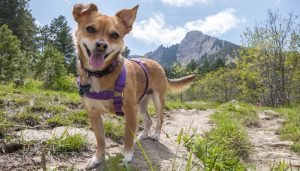 19. Stick to established trails to avoid running into unsafe terrain.
19. Stick to established trails to avoid running into unsafe terrain.
20. Pay attention as you walk to avoid holes, slippery terrain, sharp objects on the trail, or wildlife encounters.
21. Stop frequently for water breaks, but don’t let your dog drink too much at once. Give just enough water to slake your dog’s thirst.
22. Check your dog regularly for signs of dehydration or distress.
23. Watch your dog for any signs of discomfort or injury during your hike. This can include limping, tiredness, or signs that your dog is simply “finished” with your hike. Do not push him past his comfort level.
24. Keep in mind that as far as you walk, you will still need to return to your starting point. Don’t walk so far that either you or your dog are too tired to get back to your starting point.
25. Talk to fellow hikers so that they are aware of your intended path in case you become lost or injured, and so that they can inform you of any unexpected obstacles or wildlife in the area.
26. Pay attention to your dog’s behavior while hiking – it can tell you about his health as well as any changes in the environment that you may not have noticed.
27. Keep your dog on his leash at ALL times when hiking a trail; it’s about common courtesy as well as safety.
28. Using poop bags, always pick up after your dog when he uses the bathroom, even if you’re “out in the woods”.
29. Do not allow your dog to eat anything he finds on the trail or around the wooded area. Dogs, just like us, can be poisoned by any number of things…even those found in nature.
30. Do not let your dog drink from any water sources you run into during your hike unless they are in the form of water faucets or water fountains which are potable for humans. Standing water is particularly dangerous for dogs as it breeds a number of illnesses like leptospirosis and giardia.
RECOMMENDED: 5 Best Dog Water Bottles
After Returning Home…
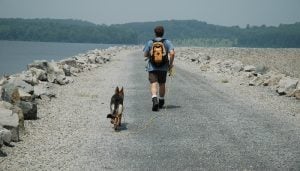 31. Wash your dog’s feet and check them for any scrapes, cuts, parasites, or other irritation even if you put boots on him.
31. Wash your dog’s feet and check them for any scrapes, cuts, parasites, or other irritation even if you put boots on him.
32. Comb your dog thoroughly to remove any debris from his coat and to check for ticks or other pests.
33. Help your dog to cool down if he shows any discomfort due to the heat. You can do this by wetting his coat with lukewarm water. DO NOT point a fan directly at a panting dog as this can contribute to bloating.
34. Let your dog rehydrate, but again, avoid letting him drink large amounts of water at once to avoid bloating or discomfort.
35. Allow your dog an hour or so to cool down and relax before feeding.
36. Watch your dog for any signs of serious discomfort following your hike. Discomfort can be a sign of heat stroke or something more serious. If you suspect that something “isn’t right” with your dog, begin by taking his temperature to rule out heat stroke (the normal temperature for a dog is 101 to 102.5) and then consult your veterinarian immediately.
37. Don’t plan another long hike tomorrow if you took one today. Just like us, our dogs need time to recover from longer periods of exertion.
READ NEXT: How to Prepare Your Dog for Camping


